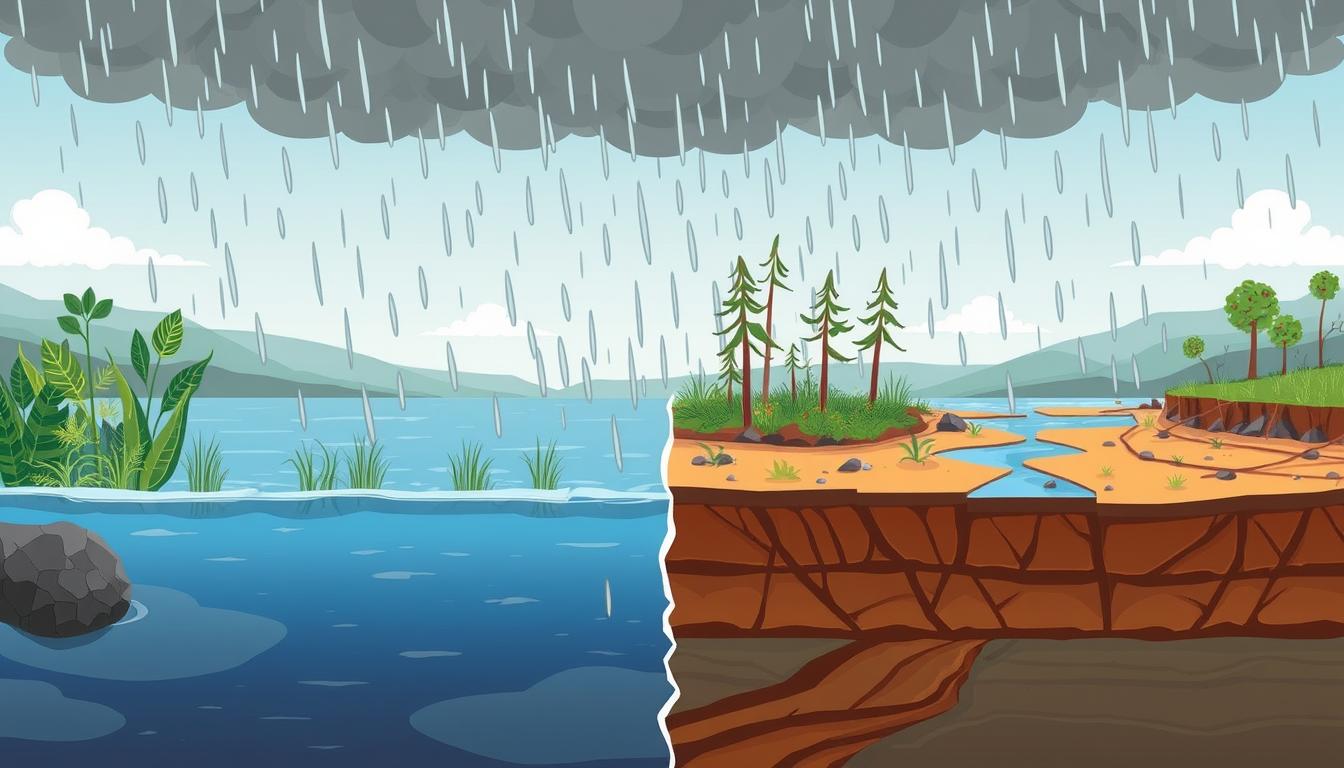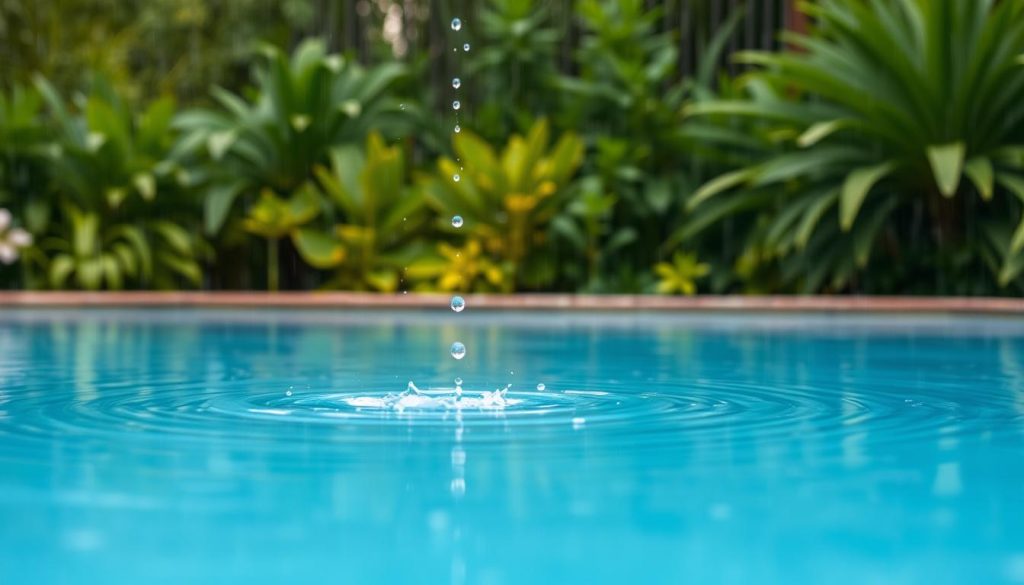
Rainwater pH usually ranges from 5.5 to 6.5. This can greatly affect pool pH levels. Pool owners need to understand how rain impacts water chemistry.
Rain absorbs contaminants as it falls through the atmosphere. These include carbonic acid and sulfuric acid from atmospheric gases. This process can result in acid rain, which has a pH below 5.6.
Acid rain has become more common over the last 40 years. This is especially true in countries like India. Uncontrolled emissions of sulfur dioxide and nitrogen oxides are the main causes.
Rain can significantly impact pool water, especially during heavy downpours. It can dilute important chemical levels in pools. These include pH, alkalinity, hardness, stabilizer, and chlorine.
This dilution can lead to cloudy water and higher chlorine demand. It can also cause algae growth. Rain washes in phosphates and nitrates, which feed algae.
The Impact of Rain on Pool Water Chemistry
Rain can greatly change pool water chemistry. It brings contaminants and dilutes chemical levels. Pool owners must understand these effects to keep their pools safe and enjoyable.

How Rain Dilutes Chemical Levels in Pools
Rain dilutes pool chemicals by increasing water volume. This affects chlorine, pH balancers, and alkalinity buffers. Imbalanced water chemistry can lead to algae growth and corrosion.
The amount of dilution depends on rainfall and pool size. Heavy rain can drop chlorine levels to zero. In such cases, pool owners may need to shock the pool.
Acid Rain and Its Effects on Pool pH
Acid rain forms when pollutants react with water in the atmosphere. It can lower pool pH levels when it falls. Acid rain typically has a pH of 5.5 to 6.5.
Low pH creates a corrosive environment for pool surfaces and equipment. Regular testing after rainfall helps maintain a balanced swimming environment.
Rainwater’s Influence on Total Alkalinity
Rainfall also affects total alkalinity, which stabilizes pH levels. Rainwater has near-zero alkalinity. Heavy rains can significantly dilute pool alkalinity levels.
A day of heavy rain can reduce alkalinity by 5 to 10 ppm. Low alkalinity causes rapid pH changes. Regular testing and adjustment prevent corrosive water and ensure proper maintenance.
| Pool Chemistry Parameter | Ideal Range | Effect of Rainfall |
|---|---|---|
| pH | 7.2 – 7.8 | Acid rain can lower pH levels |
| Total Alkalinity | 80 – 120 ppm | Heavy rains can dilute alkalinity by 5-10 ppm per day |
| Chlorine | 1 – 3 ppm | Rainwater dilutes chlorine levels, potentially reducing them to zero |
does rain raise or lower ph
Rainwater is naturally acidic, with a pH range of 5.5 to 6.5. When it enters a pool, it can lower the water’s pH level. This is due to dissolved carbon dioxide and atmospheric pollutants.
The impact of rain on pool pH depends on several factors. These include rainfall amount, initial pool water pH, and total alkalinity. Pools with lower alkalinity are more prone to pH changes from rain.
The Relationship Between Rainfall and Calcium Hardness
Rainwater has very low calcium hardness, usually close to zero. It can dilute a pool’s existing calcium hardness when it enters. This can cause problems if the pool water is already soft.
Low calcium hardness may corrode pool surfaces and equipment. It can also lead to scale deposits. However, soft rainwater can help lower high calcium hardness through dilution.
Chlorine Levels and Rain: What Pool Owners Should Know
Rainfall can significantly impact chlorine levels in a pool. It dilutes the existing chlorine concentration, lowering the available sanitizer. Rainwater also introduces contaminants, increasing the pool’s chlorine demand.
To counter rain’s effects on chlorine levels, pool owners can take several steps. Raise chlorine levels before a storm to offset dilution. Shock the pool after heavy rainfall to eliminate contaminants.
Regularly test and adjust chlorine levels to ensure proper sanitization. This helps prevent algae growth and maintains a clean swimming environment.
- Raise chlorine levels slightly before an anticipated storm to help compensate for the expected dilution.
- Shock the pool after heavy rainfall to eliminate contaminants and restore proper chlorine levels.
- Regularly test and adjust chlorine levels to ensure adequate sanitization and prevent algae growth.
| Water Parameter | Effects of Rainwater | Recommended Action |
|---|---|---|
| pH | Lowers pH due to acidic nature of rainwater | Test and adjust pH to maintain a range of 7.2-7.8 |
| Calcium Hardness | Dilutes calcium hardness, especially in soft water pools | Monitor calcium hardness levels and add calcium increaser if necessary |
| Chlorine | Dilutes chlorine levels and increases chlorine demand | Raise chlorine levels before storms and shock the pool after heavy rain |
Conclusion
Rain can significantly impact pool water chemistry. It affects pH, total alkalinity, calcium hardness, and chlorine levels. Regular testing and adjustments after rainfall are crucial for proper pool maintenance.
Monitoring pH levels prevents corrosion and equipment damage. Keeping an eye on total alkalinity helps avoid surface issues. Checking calcium hardness and chlorine levels prevents scaling and ensures proper sanitization.
Proactive pool care minimizes rain’s impact. Efficient water circulation optimizes the sanitizing process. Consider using filtered rainwater to top up pool levels.
Staying vigilant and addressing chemical changes promptly prevents algae growth. This approach preserves your pool’s longevity. It also ensures enjoyment for years to come.







